Last Updated on January 30, 2022 by Grow with Bovees
The answer to your immediate question, what is LECA, (or LECA pebbles, as they’re commonly known)?
LECA is an acronym for Lightweight Expanded Clay Aggregate.
These porous clay pebbles make it easy to regulate the distribution of water and other nutrients to your plant’s roots without submerging them.
So if you’re looking for an alternative to soil, LECA may be just what you’re looking for. In this article, we’ll examine the advantages and disadvantages of LECA. We’ll also discuss the following:
- What Is LECA?
- Advantages of Using LECA
- Disadvantages of Using LECA
- Which Houseplants Can You Grow in LECA?
- Preparing LECA for the First Time
- How Do You Use LECA?
- Can You Use Any Plant Pot With LECA?
- How to Sterilize LECA
- Transferring Plants From Soil to LECA
- LECA vs. Soil: Which Is Best?
- Can you Mix LECA With Soil?
- Can You Propagate With LECA?
- Where Can You Buy LECA Clay Balls, or Clay Pellets?
What Are Expanded Clay Pebbles?
Lightweight expanded clay aggregate (LECA) is an inorganic growing medium that you can use alone or mix with potting mix, potting soil or peat. LECA is extremely beneficial to plant growth for many types of plants.
In the production of LECA, the clay balls must endure high temperatures in a rotary kiln. First, the clay fuses and then begins to melt to form clay pebbles with a honeycomb structure.
Advantages of Using LECA Clay Balls to Grow Plants
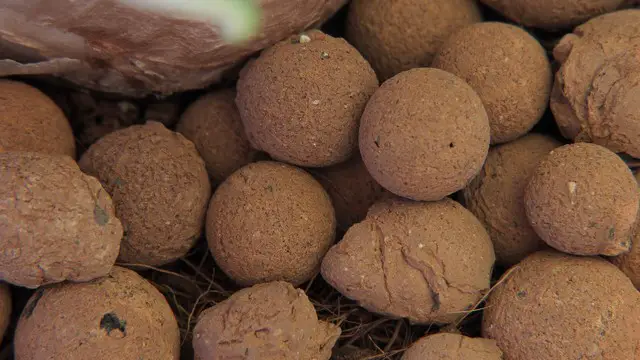
Water Drainage and Aeration
The spaces between the LECA balls make it easy to drain excess water, and provide oxygen to the roots of your plant. It can also keep plant roots away from any water at the bottom of the pot.
Oxygen deprivation and over-watering are common causes of plant loss. By providing the roots with an abundance of oxygen and keeping them away from sitting water, they’ll be more resistant to rot and disease.
Self-Watering
LECA uses capillary action to create a self-watering system. Capillary action is the process of a liquid moving through a solid object. LECA is porous, so it’ll absorb water and channel it up to your plant through the tiny capillaries in the baked clay balls. This provides your plant with water as and when it needs it.
Reusable
Although LECA is more expensive than soil, unlike soil, you can re-use it indefinitely. Soil loses nutrients over time and can harbor pests or diseases, and eventually, you’ll have to replace it.
If you re-use soil from plants you’ve lost, there’s a risk of transferring disease and pests because you can’t clean it. LECA is different. You can re-use the same batch on other plants as long as you sterilize and maintain it properly.
Stability
As your plant matures, its dense root systems will grow into the LECA, which helps anchor it into position and prevent it from toppling. The clay balls act as a stabilizing structure because the roots can’t move them about like soil.
Versatility
Some plants need specific soil types, but LECA is versatile, and it’s compatible with most plants. LECA is a neutral inorganic material. But, by adding pH solutions and liquid fertilizer, you can adjust the LECA to suit your plant’s needs.
Easy to Clean Up
Unlike regular indoor potting soil, LECA isn’t messy. When growing plants in your home, any soil spillage requires you to whip out the vacuum or grab the dustpan and brush. The great thing about LECA is that, unlike soil, it’s easy to pick up if you drop any.
Easy to Check Your Plants Roots
It’s much easier to check the root health of your plant if it’s growing in LECA. Other growing mediums such as soil and peat will cover the root ball completely, making it impossible to check them for root rot.
Disadvantages of Using LECA for Plants
Cost
LECA can be expensive in comparison to soil and other growing mediums. It also requires additional resources to make it suitable for planting. However, because it’s reusable, you won’t have the cost of replacing it.
Requires Fertilizer
LECA doesn’t contain any nutrients, so you’ll need to use fertilizer. However, you can’t use any old plant food; it requires a liquid or special hydroponics fertilizer. Hydroponics fertilizer isn’t as readily available as regular plant food, and you may need to shop around before making the switch to LECA.
pH Levels
pH affects nutrient availability. Plants tend to grow better when the pH value is 5.5 to 5.8. This is when all the nutrients are available to a sufficient degree.
The clay pebbles are pH neutral. Much like soil in the natural environment, inorganic growing media like LECA acts as a buffer which can cause pH levels to rise. Organic matter such as algae and other bacteria can also cause pH to fluctuate.
Check the pH level that suits your plant best, and you can maintain the pH using solutions designed for hydroponic use. This comes in two forms; ‘pH up’ and ‘pH down’.
Maintaining your pH levels will ensure that your plant can absorb the nutrients it needs for optimum growth.
Which Houseplants Can You Grow in LECA?

Most houseplants grow well in LECA, especially those that thrive in a well-drained environment. Plants such as Orchids, Pothos, Philodendron, and variegated Monstera all thrive in these clay pebbles.
Preparing LECA for the First Time
When opening a bag of LECA, you’ll notice a puff of dust escapes the seal. This debris isn’t something you want to expose your plant to. We don’t know what kinds of chemicals or binding agents they use to treat the LECA during the firing process. So it’s a good idea to prepare the LECA before you use it for the first time.
Step one: Remove the clay balls from the bag and rinse them thoroughly, be sure to remove any dust and debris. Doing this in your basin may cause pipe blockages. Instead, you could use a mesh bag and hose the LECA down outdoors.
Step two: Place the LECA in a container and fill it with tap water. Soak the LECA for 24 hours. This should loosen most of the dirt from inside the clay balls.
Step three: After the first 24-hour soak, pour the water away. Refill the container with fresh tap water and soak for a further 24-hours.
The LECA is ready to use after the second soak. But, it’s good practice to give the LECA a third soaking if you’re using it with high-value plants.
If you’re not using the LECA right away, dry it out and store it.
How Do You Use LECA?
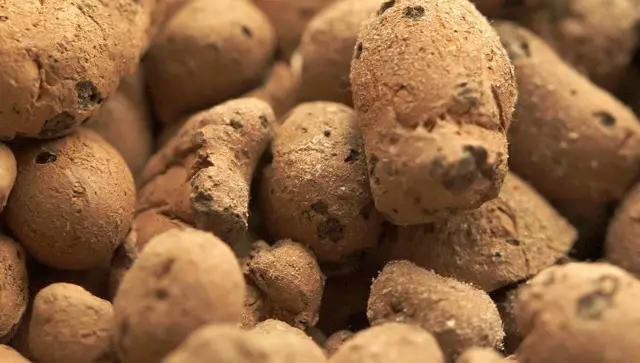
After following the preparation steps your LECA is ready to use. If the LECA is dry it needs to be soaked for 24 hours before use.
Take some clay pebbles and fill your pot up to where you want your plant to sit. Place your chosen plant in the center. This could be a cutting or a mature plant. If you’ve chosen a mature plant and it was previously in soil, gently free the roots from the potting soil.
Hold the plant in the center of the pot and place more clay balls around the sides until it’s stable.
Then add a mixture of water and nutrients to the pot until it sits just under your plant’s roots. The LECA will absorb the solution, and your plant will drink from the leca pebbles when it needs hydrating.
Your plant’s roots will never have to touch standing water, thus having a greater chance of avoiding root rot.
Once the nutrient solution has gone down, fill up your pot with pH-adjusted water.
Every two weeks flush out your LECA and clean your pot. This helps to prevent algae from growing on the clay pebbles.
Can You Use Any Plant Pot With LECA?
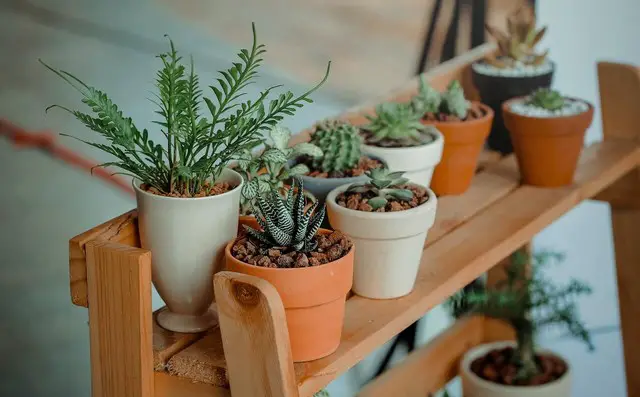
Essentially, you’ll need to use a non-draining pot with LECA. Here are a couple of systems you could try with your houseplants.
Single Pot System
You can use any pot that doesn’t have drainage holes. Once you’ve chosen your pot, drill a hole in the side approximately two-thirds of the way up. This allows the LECA to absorb oxygen and moisture and transfer them to your plant.
Glass vessels are a great idea as it allows you to see the roots, making it easier to check root health.
However, the pot will need to be flushed every couple of weeks which means disturbing your plant if you use a single pot system.
Dual Pot System
Another solution is to use an inner pot, such as a nursery or net pot and set it in a non-draining vessel.
To avoid submerging the inner pot in the nutrient solution, partially fill the non-draining pot with LECA. The inner pot can then sit, so it just touches the liquid. This will allow the LECA in the outer vessel to transfer nutrients to the LECA in the inner pot.
If you prefer to keep your plant away from the solution, you could raise it slightly higher. But you’ll have to create a wick system so the nutrients can travel to the roots. You can use anything that liquid can pass through to do this, including string or strips of fabric.
How to Sterilize LECA
You’ll need to sterilize LECA before you re-use it. This will ensure you don’t transfer any algae or disease from the previous use to your new plants.
Place the clay balls in a bucket with some hot water and move them around to rinse them through. Then, drain them and repeat the process. You can then transfer the LECA to a pot and boil the clay balls. Finally, let your LECA balls dry out for 24-hours.
Check out this video below that shows you how to sterilize LECA.
Transferring Plants From Soil to LECA
Firstly, set out two buckets of water and leave them standing till they reach room temperature. This will prevent shocking your plant when you submerge its roots.
Gently knock off any loose dirt from the roots. Then, submerge the root ball in the first bucket of water. Move it around slowly to try and tease out the leftover soil. Only the root ball should be in the water, not the plant stem.
Use a jug to take clean water from the second bucket and rinse away any residue from the roots.
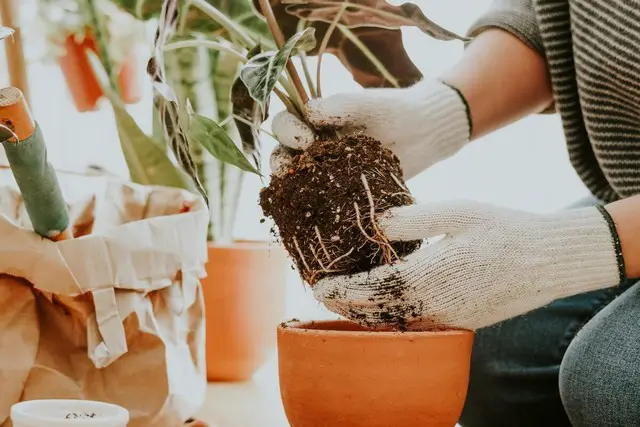
If you find any lumps of soil stuck tight to the roots, leave them. Removing them may risk damage to the roots, which may be fatal to your plant.
Your plant is now ready to transfer to the LECA.
LECA vs. Soil: Which Is Best?
There is no clear-cut answer to this question. Both soil and LECA have their advantages, and some plants may have a preference. Ask yourself these three questions before transferring your plant to LECA.
Does my plant need fertilizer? If the answer is yes, you may be able to transfer your plant to LECA. Not all plants do well with a hydroponics fertilizer, and some prefer to gather nutrients from an organic growing medium.
Does my plant enjoy an oxygen-rich environment? Clay balls create an abundance of space for oxygen, and most plants love an aerated growing medium.
Usually, insects and worms move the soil around to create air pockets. But, indoor plants don’t have this helpful luxury and may benefit from living in LECA.
However, not all plants like oxygen-rich conditions and LECA may do more harm than good.
Does my plant like being handled? If your answer is no, it’s probably best to leave your plant in the soil. Using LECA requires you to frequently handle your plant so you can clean the clay pebbles.
You’ll also have to clear the soil from the roots when transferring your plant, which requires a lot of handling.
Can You Mix LECA With Soil?
Yes, you can mix LECA with soil. Mixing mediums will improve aeration, drainage, and it’ll also help retain moisture.
Can You Propagate With LECA?
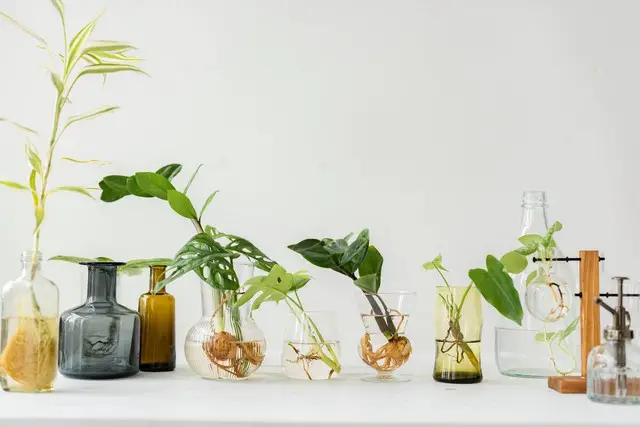
LECA is an excellent alternative to using water alone when propagating, as the clay balls will help stabilize the cutting.
First, prepare your LECA and soak it overnight. Half fill a glass container with the clay balls, put your cutting in and place more LECA around it. Leave an inch of space in the container.
Lastly, add water until it comes to about an inch from the top of the LECA. Keep a close eye on the water levels as these will keep dropping due to evaporation.
Where Can You Buy LECA Clay Balls, Clay Pebbles or Clay Pellets?
LECA products are available online and in most large hardware stores. Other hydroponic resources, such as fertilizer and pH solution, are also available from these places.
Final Thoughts
LECA is an excellent alternative to other growing media such as soil. It’s a self-watering system that will help prevent water-logging and suffocation, two common causes of plant fatalities.
Although the initial set-up may be costly, LECA may save you time and cash long-term, as it’s self-sufficient and reusable indefinitely. So, know you know what LECA is, why not give it a try. Your plants may be rooting for LECA.
Resources;
https://www.leca.co.uk/products/Leca-Flower
https://www.usgs.gov/special-topics/water-science-school/science/capillary-action-and-water

